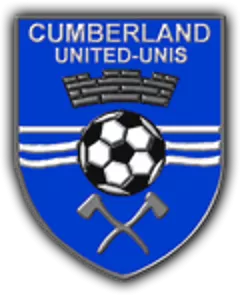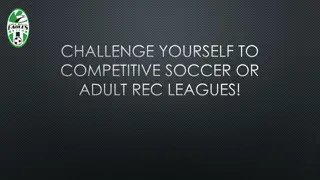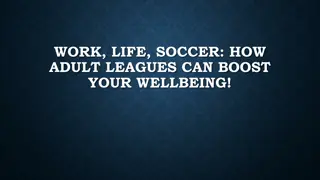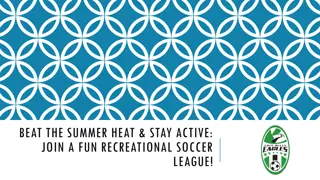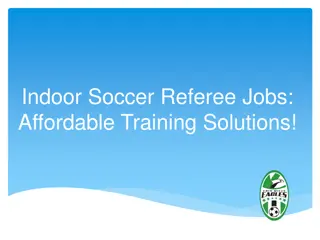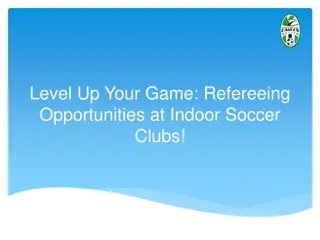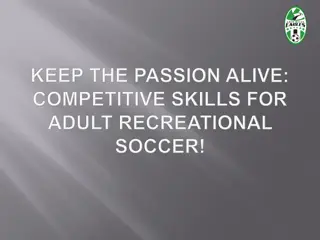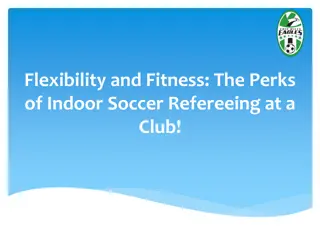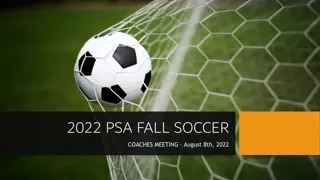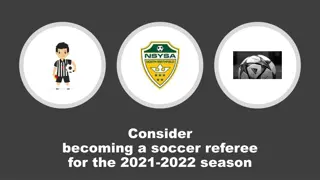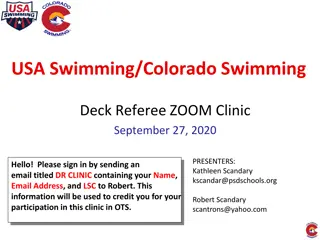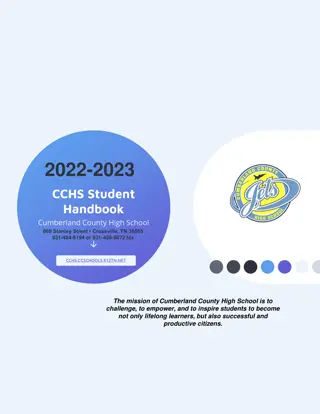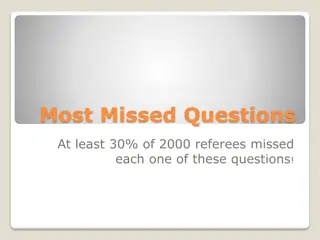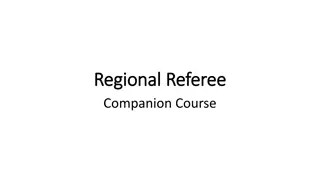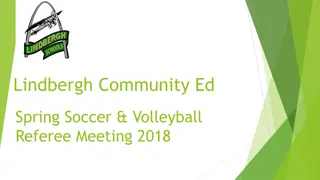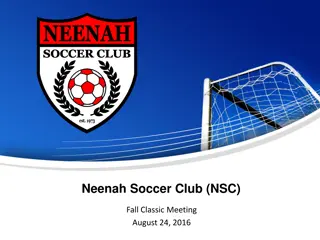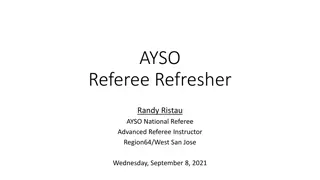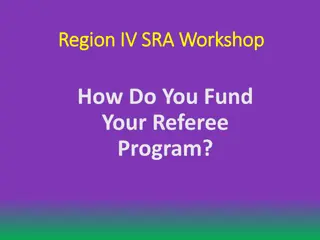Cumberland United Soccer Club Referee Orientation and Refresher
The Cumberland United Soccer Club held a referee orientation and refresher session covering topics such as 2015 updates, rates of pay, OSA policies, and the referee mentor program. New referees were introduced to club policies, and mentorship opportunities were discussed to enhance referee development. Coach development sessions and resources for information were also highlighted.
Download Presentation

Please find below an Image/Link to download the presentation.
The content on the website is provided AS IS for your information and personal use only. It may not be sold, licensed, or shared on other websites without obtaining consent from the author. Download presentation by click this link. If you encounter any issues during the download, it is possible that the publisher has removed the file from their server.
E N D
Presentation Transcript
Cumberland United Soccer Club Referee Orientation and Refresher
Agenda Introduction What s new for 2015 2015 Rates of Pay & Forms OSA Policies and changes to the laws of the game LeagueGM Tips New Referees: What to expect CUSC Policies
Introductions Chris Wade, Head Referee Email: headreferee@cumberlandsoccer.com Phone: 613SOCCER1 (613-762-2371) Alan Ellis, Referee Assignor and office administrator Email: admin@cumberlandsoccer.com Phone: 613-720-1311
Whats new for 2015 Referee Mentor program This is a pilot project in the province. Referees attended a three hour course on the importance of mentoring, distinguishing mentoring from coaching and how to provide effective feedback.
What is the mentoring program? Initially, mentors will be assigned to work with new referees for 2015. These mentors will help in the development of new referees by providing feedback, answering questions and potentially relating some of their own experience. This program will be rolled out province-wide in 2016. They will also be introducing a district referee coach program. Referees looking to advance and upgrade may be assigned a coach to help them in their development. We will be looking for more referees next year who are interested in becoming mentors
Coach Development Sessions I will be meeting with both competitive and recreational coaches this year to discuss working with referees. The session will cover common areas of disagreement and how and when to approach a referee
Where to start for information? Cumberland Website: www.cumberlandsoccer.com Check out the Referee s corner, under Resources
Rates of Pay Summer Season Winter Season Age Group Referee A/R Age Group Referee A/R U8 $15 N/A U5-U12 Futsal $20 N/A U9 $18 N/A U13-U17 Futsal $25 N/A U10 $20 N/A Adult Futsal $30 N/A U11 $20 N/A Adult Dome $30 N/A U12-U13 $30 $17 U14-U15 $33 $19 U16-U18 $40 $20 Adult $45 $25 Adult Co-Ed $30 N/A U18 7v7 $30 N/A
OSA Referee Uniform Policy All Match Officials in Competitions under the jurisdiction of The CSA and OSA must wear uniforms comprising plain black (Adidas grey is considered black) shirts and black shorts. Socks shall be black.
OSA Referee Uniform Policy Referees may only wear an alternative colour uniform when there is a clash between the uniform shirts of the outfield players of one of the teams and the referee s first choice colour. The preferred alternative second choice colour is yellow, the third
OSA Referee Uniform Policy Referees may only wear an alternative colour uniform when there is a clash between the uniform shirts of the outfield players of one of the teams and the referee s first choice colour. The preferred alternative second choice colour is yellow, the third BLUE
OSA Law 4 Memo (2009) Jewellery Protective Equipment Hats & Bandanas Head Protectors Eyeglasses Orthopaedic Supports Casts Footwear Jerseys
OSA Law 4 Memo (2009) Jewellery: All items of jewellery (necklaces, rings, bracelets, earrings, leather bands, rubber bands, etc.) are strictly forbidden and must be removed. Using tape to cover jewellery is not acceptable.
OSA Law 4 Memo (2009) Hair Bands: the use of something to keep long hair out of players eyes the OSA permits the following: scrunchies and cloth-covered elastic bands. Also permissible is the use of an invisible bra strap or Pro Wrap (a prewrap tape). Players are NOT permitted to wear elastic bands or hair clips.
OSA Law 4 Memo (2009) Hats: A hat may be worn by the goalkeeper provide that : it is not a baseball cap if it has a peak it must face forwards and be a soft peak contains no metal or plastic parts
OSA Law 4 Memo (2009) Bandanas - no bandanas are allowed. Head protectors: Are allowed provided that its sole purpose is to protect the player physically and it poses no danger to the individual or any other player. They must be made of soft, lightweight padded material.
OSA Law 4 Memo (2009) Orthopaedic supports, e.g. knee braces - FIFA Circular 863 states that the vast majority of commercially manufactured supports are safe to use. Knee and arm protectors made of soft, lightweight padded material are not considered dangerous. Any support must be safe for all players, and adequately padded and covered if necessary.
OSA Law 4 Memo (2009) Casts: Hard plaster casts are considered to pose a danger to both the wearer and other players and are not permitted to be worn. The practice of padding a hard plaster cast does not reduce the element of danger. Players wearing a soft, lightweight, cast will be permitted to play if the cast does not present a danger to the individual or any other player.
OSA Law 4 Memo (2009) Footwear: Referees are encouraged to incorporate a footwear inspection in the pre-match safety check of players equipment. - Poorly maintained studs or blades on the sole of the boot can constitute a danger
OSA Law 4 Memo (2009) Jerseys: All jerseys must have sleeves. The players may not roll the sleeves up or tie them at the shoulder level.
Long Term Player Development The introduction of Long Term Player Development (LTPD) is triggering changes in how coaches educate their teams. In terms of officiating, some minor changes are being introduced: U11 and U12 games are now 9 vs. 9 games, played on a minis field. All rules related to game play are available on the website.
LTPD - Retreat line When the goalkeeper has the ball at a goal kick or after making a save the opposing team members would "retreat" to the predetermined area of the field. The predetermined areas are as follows: 5v5 - Half way line. It is recommended the goalkeeper does not drop kick the ball 7v7 1/3rd line. 9v9 - 1/3rd line. With the opposition retreating to the correct part of the field the goalkeeper can now successfully throw or pass the ball to a team mate. Once the player receiving the ball from the goalkeeper receives the ball, the ball is in play and the opposition players can pressure and attempt to win the ball.
LTPD - Retreat line If the goalkeeper chooses not to wait for the opposing players to "retreat" and throws or passes the ball down the field, the ball is instantly in play and does not require a player from the goalkeeper s team to touch the ball first. The ball is in play once it leaves the penalty area (7v7/9v9) All opponents must be behind the retreat line and cannot cross the retreat line until the ball: Is touched by a player of the team taking the goal kick OR, Leaves the field of play OR, Goes over the retreat line. (If the goalkeeper chooses to play the ball across the retreat line prior to the opposition crossing the retreat line)
Changes to the Laws of the Game 2012 Law 4: Headscarves The headscarf Must Be of the same colour as the jersey (Please use common sense with this) Be in keeping with the professional appearance of the player s equipment Not be attached to the jersey Not pose any danger to the player wearing it or any other player ( e.g. opening/closing mechanism around neck ) Only be worn by female players
Changes to the Laws of the Game 2012 Law 4: Tape if tape or similar material is applied externally it must be the same colours that part of the stocking it is applied to Referees of recreational games are asked to relax this rule and allow tape of other colours.
Changes to the Laws of the Game 2012 Law 8: Start and restart of play Dropped ball If the ball enters the goal: if a dropped ball is kicked directly into the opponents' goal, a goal kick is awarded if a dropped ball is kicked directly into the team's own goal, a corner kick is awarded to the opposing team
Changes to the Interpretation of the Laws of the Game 2013 Law 11 In the context of Law 11 Offside, the following definitions apply: interfering with play means playing or touching the ball passed or touched by a team mate Interfering with an opponent means preventing an opponent from playing or being able to play the ball by clearly obstructing the opponent s line of vision or challenging an opponent for the for the ball
Changes to the Interpretation of the Laws of the Game 2013 Law 11 gaining an advantage by being in that position means playing a ball That rebounds or is deflected to him off the goalpost, crossbar or an opponent having been in an offside position That rebounds, is deflected or is playing to him from a deliberate save by an opponent having been in an offside position. A player in an offside position receiving the ball from an opponent, who deliberately plays the ball (except from a deliberate save) is not considered to have gained an advantage
LeagueGM Set and manage your availability Set your field preferences New Mobile version for common tasks New online training on how to set up LeagueGM is available
CUSC Policies Quick reminder: Slide tackles are not permitted in CUSC recreational games. This is considered dangerous play. The referee should consider the proximity of other players when making this call. If the slide is done with no players in proximity, sliding is not, in and of itself, dangerous play.
What to expect All new referees should expect a mentor to attend a game during the season. This is NOT a pass/fail. It s intended to provide advice and help you in developing as a referee. Returning referees: If you are looking to take on more challenging assignments and are looking for an upgrade, request a mentor attend a game and provide feedback.
Myth or No Myth - 1 Playing the ball on the ground
Playing the ball on the ground? Answer: Myth Players may battle for the ball while lying or sitting on the ground, provided that in the opinion of the referee, doing so is dangerous to neither himself nor to any other player. It is not an offense by itself to challenge for the ball while on the ground.
Myth or No Myth - 2 High Kicking
High Kicking Answer: Myth: Again, players may have their boots as high as they like provided doing so is not dangerous to an opponent. There are several opportunities to safely put the boots high to control the ball with no opponents around. Just like the previous myth, the offense would be "playing in a dangerous manner". If there is no danger to an opponent, then no offense has been committed.
Myth or No Myth - 3 Only the captain or the assistant captain who is currently on the field during the call is allowed to discuss the call with the referee
Captain Privileges Answer: Myth Law 12 (Interpretation of the laws of the game and guidelines for referees): The captain of a team has no special status or privileges under the Laws of the Game but he has a degree of responsibility for the behaviour of his team. Captain is mentioned twice more in the LOTG: Kicks from the Penalty Mark: The referee tosses a coin and the team whose captain wins the toss decides whether to take the first or the second kick If at the end of the match and before the kicks start to be taken from the penalty mark, one team has a greater number of players than its opponents, it must reduce its numbers to equate with that of its opponents and the team captain must inform the referee of the name and number of each player excluded.
Myth or No Myth - 4 You can't twist when you take a throw in
Throw-In Answer: Myth It is not an offense in and of itself to twist the upper body during a throw-in. This may come as a surprise as we have all heard referees say this is not allowed. Law 15 of the FIFA Laws of the Game requires 5 things to be present for a throw to be legal. At the moment of delivering the ball the thrower: faces the field of play has part of each foot either on the touchline or on the ground outside the touchline holds the ball with both hands delivers the ball from behind and over his head delivers the ball from the point where it left the field of play Provided each of these are met, the throw is legal - no matter what else happens. It is likely that it is from a misinterpretation of the first of these points that the "No twist" myth was born; however, clearly it is possible for the thrower to face the field throughout the throw while twisting the body.
Myth or No Myth - 5 Put a name on the ball She can't say 'My Ball' she has to call for it using her name!"
Put a name on the Ball Answer: Myth! This is one I am sure we have all heard. The Laws of the Game make it perfectly permissible to call for the ball using terms such as 'mine', 'I got it', 'dummy', 'leave it', etc. The only instance that this would be punished, is if in the opinion of the referee, the shout was DELIBERATELY INTENDED TO DECEIVE AN OPPONENT. If there is even the slightest possibility that the player was talking to a teammate, then no offense has been committed - regardless of whether or not the opponent is distracted.
Myth or No Myth - 6 You have to call the unintentional handball if the player gets an advantage
Unintentional Handball Resulting in Advantage Answer: Myth This is an easy one to explain. If the ball hits the hand, the handling is not deliberate provided that in the opinion of the referee, the arms were in a natural position, no offense has been committed - PERIOD! This is true even if the ball accidentally hit the hand (or arm) and bounced right to the same player's feet.
Myth of No Myth - 9 Shoulder to Shoulder is always a legal charge
Shoulder to Shoulder Answer: Myth This claim comes out at least once per game. Players all over assume that shoulder to shoulder challenges are fine no matter what. The first thing that I would like to say to players, is that often these 'shoulder to shoulder' challenges are in fact one player's shoulder in the other's back. There are several criteria that each player must meet for such a challenge to be legal: The ball must be within playing distance Player must attempt to play the ball Excessive force is not used by either player. No body checking, Elbows down, shoulder does not dip down. Each player keeps at least one foot on the ground during the charge If, AND ONLY IF, all of these criteria are met, the challenge is legal.
Myth or No Myth - 11 Free-Kick: Opponents don't have to back up unless the kicking team asks for the 10 yards distance
Player does not have to move back unless the kicking team asks for 10 yards Answer: Myth The offending team caused the free kick. It is their responsibility to move back the required distance without delay, and without having to be told. They have no right for time to set a wall, and the referee must not allow them that time. The kicking team does not either have to take permission to take the quick kick. It is the duty of the Referee to let the team taking the free kick to do so as quickly as possible, without interference by the other team or by the referee. It is accepted that if the attacking team takes a quick free kick, then they cannot complain if the ball hits an opponent who was making a genuine effort to retire. Play should be allowed to continue in such circumstances.
More Myths or No Myth Last minute: Not enough time for substitution. Allow? Restarts: Ball has to travel its complete circumference to be in play. True or False? Challenging the Goal Keeper inside his goal area. Allow? Goalkeeper allowed to jump with knee up to protect himself/heself? Tucking the shirts in? Taping jewelery. Allow? Feinting and trickery in taking the kick or penalty kick. Allow? Can you send off a spectator? Would you allow a megaphone among spectators? Can the goalkeeper score with his hand by throwing the ball in the opposing net from inside his penalty area? Tackling getting the ball first, always legal? Foul starts outside penalty area, then continues inside. Penalty?


